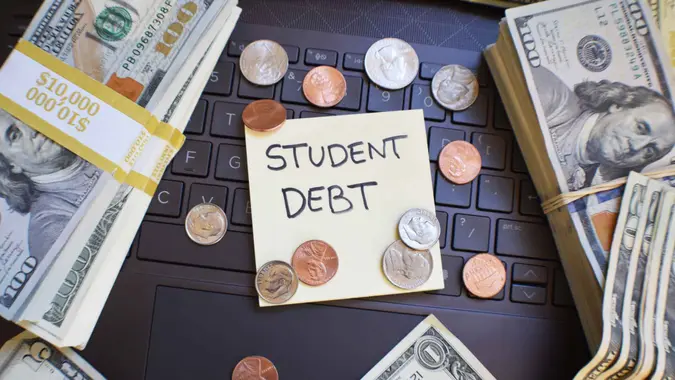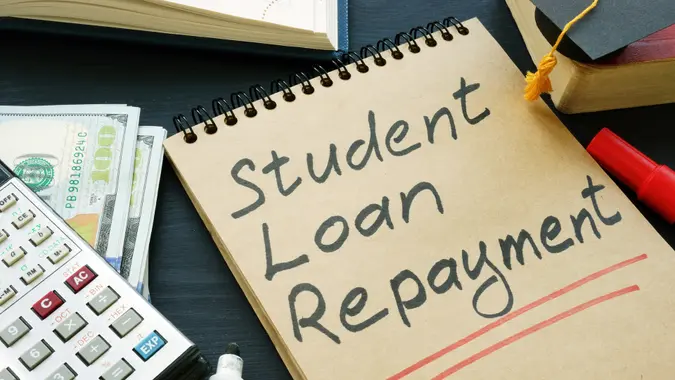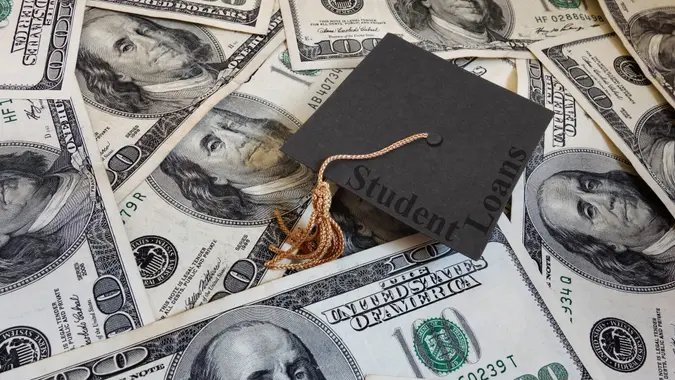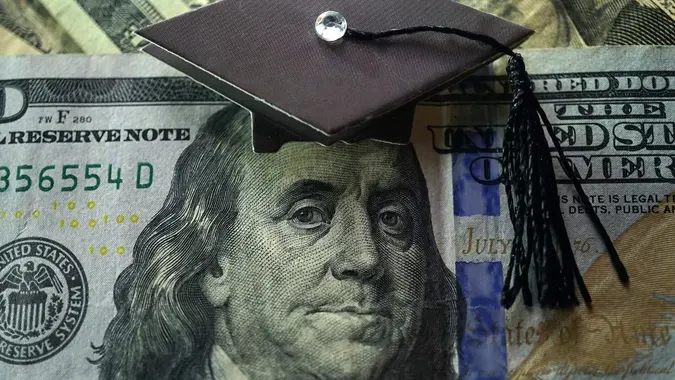Student Loans: 37% of Borrowers Have Not Saved Enough in Anticipation of Repayment

Commitment to Our Readers
GOBankingRates' editorial team is committed to bringing you unbiased reviews and information. We use data-driven methodologies to evaluate financial products and services - our reviews and ratings are not influenced by advertisers. You can read more about our editorial guidelines and our products and services review methodology.

20 Years
Helping You Live Richer

Reviewed
by Experts

Trusted by
Millions of Readers
The resumption of student loan payments in October -which were paused since the pandemic- is set to put an immense dent in millions of Americans’ budgets. This follows the Supreme Court – in a 6-3 June 30 decision- striking down President Biden’s student loan forgiveness program.
Making matters more burdensome, a combination of factors including inflation, soaring rates and the fact that many of these borrowers have accumulated additional debt during the payment pause, are making experts raise the alarm.
Indeed, a recent Credit Karma survey found that a staggering 37% of federal student loan borrowers say they have not saved money in anticipation of resuming their payments. Already, 53% of them say they are currently struggling to pay other bills.
In turn, 45% of these borrowers expect to be delinquent on their loans once the resumption, with borrowers with an annual household income of less than $50,000 being significantly more likely than those with one above $100,000–53% versus 36%, respectively, the survey found.
“Student loan debt is putting many consumers over the edge in debt, and that means they will need to figure out ways to deal with that non-student loan debt,” said Andrew Housser, co-CEO and co-founder of Achieve. “If they’ve been struggling with credit card debt, they may need to look at debt resolution (settlement), a debt consolidation loan, a HELOC or other to help them through. From my perspective, there’s no ‘one size fits all’ approach.”
And already, many borrowers are looking at solutions and at making changes ahead of the resumption. These include 49% considering decreasing spending on non-necessities; 40% say they will take on additional work; 34% say they will apply for an income-driven-repayment (IDR) plan; 26% will dip into emergency savings; 25% will put off key financial milestones; and 23% will decrease retirement savings, according to the survey.
Bridget Haile, vice president of operations and client experience at Summer, noted–citing data from Empower–that the average monthly payment is about $400 per month, and one-in-three households with student debt expect to pay $1,000 each month toward their student loans. In turn, borrowers are bracing for a significant new monthly expense when payments resume after over three years on pause, she added.
“This is against the backdrop of an economy that looks much different than it did a few years ago, with most American borrowers having lost any excess savings,” added Haile. “Between inflation, the previous promises of debt erasure, and the uncertainty around when repayments would restart, it’s no surprise that so many don’t feel prepared.”
Tips for Those Needing To Pay Off Student Loan Debt
According to Housser, there are steps borrowers can take to alleviate this incoming financial burden. First, make sure to have a strong budget in place – one that covers each month for the year, and then projects out for the life of the loan. Then, see if you qualify for loan forgiveness programs in your profession.
“Teachers or those who work for government or not-for-profit organizations still may qualify for loan forgiveness. Other professions have programs that help repay student loans. Your industry’s association(s) or employer human resources department may have information,” he said.
Another step is to consider an IDR, these plans, which set monthly payments at an amount that is intended to be affordable, are complex and need some research time.
“They are designed for people who can’t afford their current monthly payments. Family size and income determine payments. Eligibility is based on income, loan balance and the type(s) of federal student loans that you currently have,” he said.
Housser added that there are four types of plans:
• PAYE: Pay As You Earn
• REPAYE: Revised Pay As You Earn
• IBR: Income-Based Repayment
• ICR: Income-Contingent Repayment
Borrowers can also look at refinancing, which involves obtaining a new loan, the proceeds of which you’d use to pay off your existing student loans.
“That new loan might have a different repayment term shorter or longer, and/or a lower interest rate. Refinancing is available only through private lenders. So, those with a government-provided student loan would lose all federal benefits if they turned the loan into a private one,” added Housser.
Finally, Housser said you can consider consolidating student loans, which involves grouping multiple loans into one loan, to eliminate a fixed rate for a variable one, or get a different repayment term.
“Consolidating may result in a lower monthly payment – but at the same time extend the repayment period. Consider the short-term needs and long-term consequences carefully,” he said, adding that the federal government’s Direct Loan Consolidation program consolidates only federal student loans. Private lenders are able to consolidate federal and private student loans.
Yet, according to Summer’ s Haile, a worrying finding from the CreditKarma report is the low percentage of Americans considering IDR where possible, with 34%.
“The Biden Administration’s new SAVE plan will provide a huge opportunity for borrowers to lower their student loan payments and limit interest growth while also setting themselves up for forgiveness,” she said, adding that monthly payments could be halved -or more-for borrowers with undergraduate debt, and borrowers making under $30,000 annually will be eligible for $0 dollar monthly payments.
She added that the Congressional Budget Office estimates that up to 73% of all borrowers will be able to save under this new program, which presents an essential lifeline to those who will struggle with repayment.
“Borrowers can enroll in the plan now to access some benefits when payments resume–like a cap on accruing interest–while other benefits like the lower monthly payment percentage will go into effect next year,” she said.
More From GOBankingRates
 Written by
Written by  Edited by
Edited by 
























